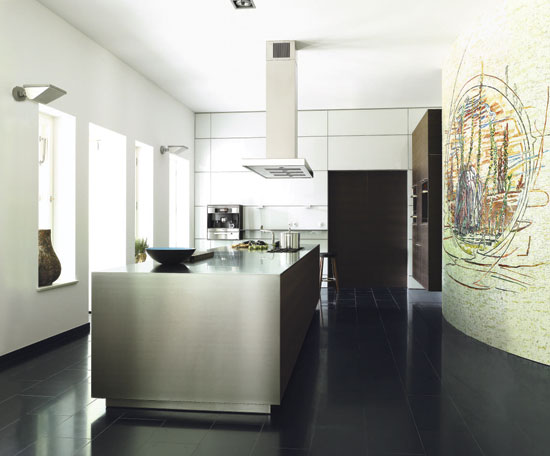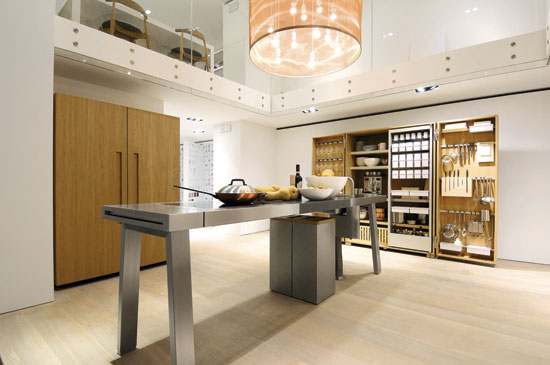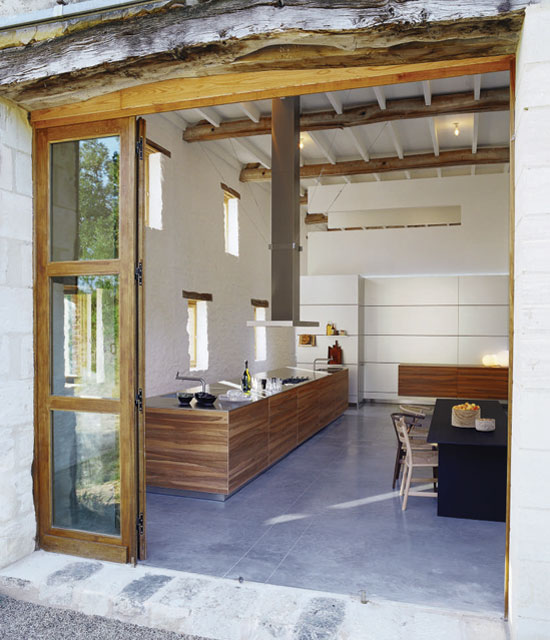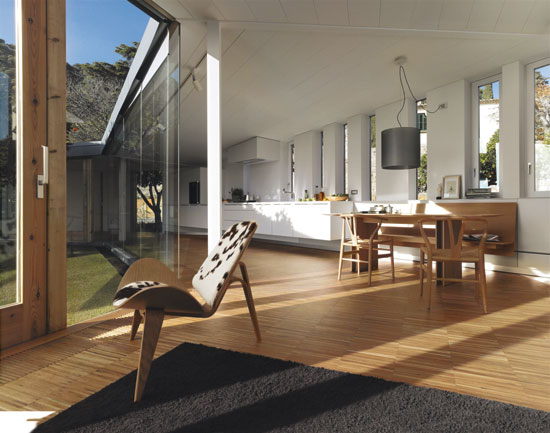Minimalism in the Kitchen
Form follows function in new generation systems that maximize efficiency, ergonomics, and aesthetics
![]() Continuing Education
Continuing Education
Use the following learning objectives to focus your study while reading this month’s Continuing Education article.
Learning Objectives - After reading this article, you will be able to:
- Identify the design philosophy of a minimalist kitchen as it relates to health, safety, and welfare.
- Discuss the ergonomic rationale for placement of elements within a kitchen space.
- Explain how the interior design of drawers and pull-outs relates to a personal sense of space and autonomy.
- Describe how kitchen design and materials can achieve sustainability goals through resource conservation and energy efficiency.
Every architect knows Louis Sullivan's famous maxim, form (ever) follows function, a guiding tenet of the modern aesthetic. Sullivan's idea that the purpose of a structure should be the starting point for its design has produced minimalism, which seeks to eliminate all non-essential forms, features, and concepts—no easy feat to accomplish.
Noted architect John Pawson maintains that minimalism is not merely a case of “throwing out the sofa and painting the walls white.” “This is not architecture of absence: It is defined not by what is not there, but rather by the rightness of what is,” Pawson writes. “You reduce, you simplify and at first there is less and less to look at. Then, as you go on attenuating and compressing, you come to a point at which you go through a barrier and pass through into…a kind of mirror world, in which you see, looked at with enough clarity, not emptiness but a sense of richness.”
In the kitchen, a form follows function minimalist philosophy has resulted in transformation of a traditional space to flexible structures and systems that are both efficient and sculptural, and that mirror current social trends, accommodate changing lifestyles, and satisfy people's longing for individuality and authenticity.
This article will explore these kitchen systems and their components in the context of current trends and social ideals, as well as their consistency with ergonomic, sustainable, aesthetic, and cultural goals.
Kitchen Trends
Food preparation is in. The past years have seen a booming interest in food—healthy, gourmet food made at home. Cooking has become a pastime enthusiastically embraced by both women and men. This applies not only to family meals but in light of the recent economic downturn to a return to in-home entertaining. All these factors have given rise to a new importance of the kitchen, and today's kitchens are increasingly recognized as the hub of the house. They are open-concept, flexible spaces and often an extension of the great room—a trend that designers say will continue to prevail. “Homeowners know that the kitchen is truly the center of the home well beyond food preparation,” says New York architect and residential design specialist Judith Raymond. “The separation between kitchens and dining rooms is coming down to create a more open space where family and friends can gather as dinner is being prepared and after dessert as well. People don't want to have to go from room to room to entertain. The kitchen is where they want to be.”
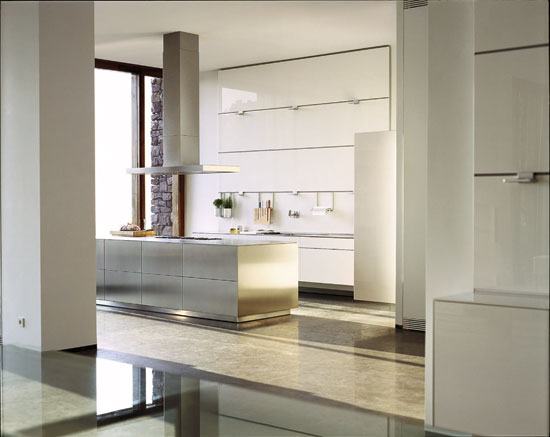 |
Minimalist kitchens are both efficient and aesthetically pleasing. Photo courtesy of bulthaup |
To further their culinary pursuits, home cooks increasingly want chef's kitchens and the latest in appliances and workspaces. To enhance the kitchen's appeal as an entertainment area, many consumers are turning to sophisticated, high-end design solutions that incorporate both practical and aesthetic advantages in an integrated look. “As designers, we have to combine the 'showplace' living room with the 'down and dirty' kitchen functions—incorporating all sorts of cooking, refrigerating, and dishwashing equipment, while balancing the qualities of form, proportion, materials, lighting, color, and details that make a room beautiful and convey the owner's style,” says Raymond. Contemporary minimalist kitchens, which by their very nature are stylish, clutter-free, and ergonomically developed, continue to be popular choices in all demographics, from young urbanites to retirees renovating a country home.
The System Defined
New generation kitchen systems combine functionality and ergonomics in a sensual minimalist form. The design itself is based on a scientific look at workflows and movements in the kitchen. In conventional kitchens it is difficult to reach certain areas without bending down or stretching. The pivotal ergonomic principle of minimalist systems is that everything should be within easy reach and, as a result, the system eschews all hard-to-access areas located high up or down low. Instead, the middle functional area directly above the worktop becomes the focus, with slender, modular panels allowing for flexible kitchen design that mixes visible functional zones. Drawers and pull-outs give users the freedom to shape, structure, and fill space according to their unique tastes and needs. In line with the principle of intuitive function, people become “directors” who modify the scenography of their kitchens, making changes as they like and purchasing additional functions and elements as they need them.
Design Precedents—Bauhaus, Donald Judd, Shaker Furniture
Rooted in the Bauhaus tradition, today's kitchen design systems take inspiration from the minimalist artists of the 1960s, notably Donald Judd. A chief proponent of minimalism, Judd used industrial materials to create objects that were severely reduced in form and not presented on the usual pedestals, but created an interplay between interior and external form, and light and shadow. It is this imitation of sculptural yet lightweight appearance that minimalist kitchens mirror.
Another influence was Shaker furniture of the 19th century, the iconic self-made, high-quality home furniture that combined functionality, material authenticity, and simplicity. Particularly influential was the movement's seminal wooden peg rail from which clothes, everyday objects, and small items of furniture hung from finely crafted hooks, arranged at regular intervals.
The Active Wall and Other System Installation Options
While inspiration may have come from Shaker peg rails and contemporary art, the idea of “actively using the wall” was the core innovation of some minimalist kitchens. In these kitchens, a multifunctional wall becomes the structural base element of the entire kitchen system. Affixed to the wall is a sturdy steel skeleton from which cabinets and worktops, cooktops and water points, electrical appliances, and a myriad accessories all hang on special hooks, making the unit appear to “float.” The steel frame is secured both to the wall and the floor and should be able to support up to 2,200 pounds per foot, and transfer the forces into the ground. Power and gas supply lines are routed behind the wall. This scenario enables maximum use of the space between the wall and base units, and offers the ergonomic advantages of eliminating the need to bend down to reach a bottom drawer, and enabling the area underneath the units to be easily cleaned.
| A Kitchen System of Stainless Steel and Marsh Oak | ||
In Berlin, the architect and the new owners of a historic home decided to incorporate a modernist touch. While upstairs, the bedrooms, marble bathroom, and children’s rooms remained as they were a century earlier, the ground floor had been divided differently. Since servants who once prepared and served meals were no longer a feature of the house, it seemed obvious to place the kitchen next to the dining room. Combining owner preferences and the principles of “objectivity, function, and quality,” a system made of stainless steel and marsh oak was selected. A monoblock integrated with sink and gas cooktop was chosen to form the focal point of the room. The former ladies’ parlor and the music room had been joined to form the dining room. Only the floor—a dark basalt in the cooking area, an authentically reconstructed parquet floor in the dining room whose marsh oak takes the color of the kitchen fronts—provides a visual distinction between the cooking and the dining areas. To honor architectural conditions and existing materials, the kitchen makes use of special veneers, for planning and implementing kitchen architecture.
|
To properly use the multifunction wall's steel supporting frame, wall conditions must be suitable and wall thickness adequate. As a general guideline, wall-hung scenarios are suitable for units of up to 26 inches deep, even if loaded with heavy crockery and large electrical appliances. When units are 30 inches deep or more, however, only the foot-supported or floor-standing versions are feasible. All three types of installation can create a “floating” kitchen, which both facilitates working efficiently within the space and imbuing it with a stylish, lightweight appearance.
In cases where the structural requirements for the wall-hung kitchen are not met and a floating impression is still desired, kitchen elements in the wall line can be placed on a support platform, with working heights that are chosen to meet individual needs. Designers can select from different types of feet. A U-shaped, curved type foot will give the kitchen furniture an airy appearance, while a classic, strict pillar foot will accentuate the rectilinear look of the systems.
Floor-standing elements are the best solution for traditional room designs where storage space must be maximized. A minimalist design with a nearly invisible recessed plinth means that these elements do not dominate the room and maintain the kitchen's “floating” appearance. The floor-standing version is ideal for a classic kitchen island, positioned in the center of the room.
Achieving the Rectilinear Look—Laser Technology and Seamless Joints
Contemporary architecture and modern product design require the consistent, continuous, rectilinear use of form and the use of uniform materials that are the linchpin of the minimalist aesthetic. Laser welding technology has long enabled manufacturers to create design solutions that eliminate joints and fuse surfaces together seamlessly. To achieve a seamless stainless steel finish, for example, ultra thin fronts are made of a light carrier plate, which is surrounded by two stainless steel half shells. The half shells are laser welded to the edges and, after polishing, the stainless steel front appears completely seamless, as if it were made from a single mold.
The technique is also applied to laminates. The laminate edges are heated and then fused together to create an optically imperceptible seam. The advantage of this is that the bond is formed without the usual adhesive, which can become visibly discolored in time. Thus fabricated, laminate fronts appear as if they have been made from a single mold with the appearance of an expensive lacquered front, yet without the cost premium and high maintenance of lacquer. Manufacturers also apply this process to aluminum and wood. Laser welding enables other connections, too, including seamless integration of the water point into the worktop.
Workspaces
In the minimalist kitchen, efficiency is key. Several areas within the kitchen are used as workspaces.
The Active Wall
As the cornerstone of a minimalist kitchen, the active wall offers numerous design and functional advantages as a result of wall panels and accentuation of the horizontal lines. Wall panels can be suspended with or without shelves. For added strength, shelves can be bonded invisibly at the factory to the panels. Kitchen designers make much use of what is known as “the functional gap,” a small, less-than-half-an-inch space located between the panels, to suspend all manner of useful elements—cookbook holders, paper towel holders, knife blocks, herb pot holders, shelves with or without inserts for spice jars, and food containers as well as coffee makers, and TV and audio systems. These elements are not fastened to the panels themselves but are instead suspended in the gaps, which confers great freedom in changing their order or placement, or substituting other elements. Functional elements can be suspended at any point and at any height in the function gap, or fastened directly at gap height.
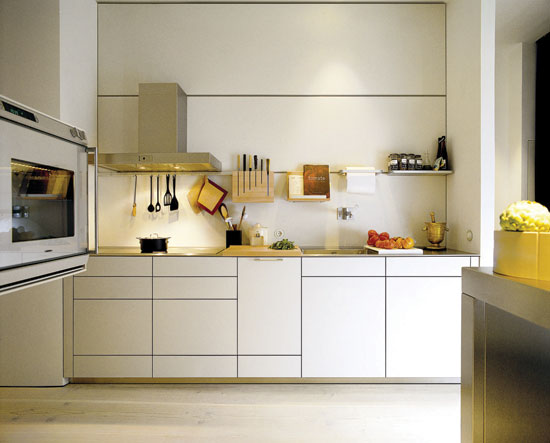 |
Useful kitchen elements can be suspended in the gap between wall panels. Photo courtesy of www.bulthaup-odeon.com/english/b3_idee_2.php |
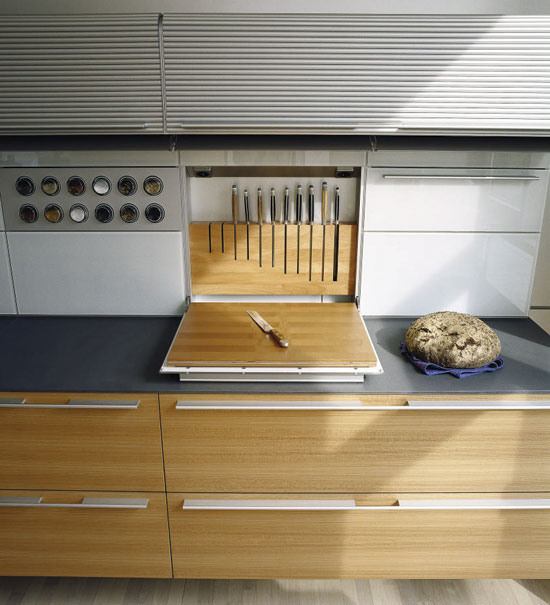 |
This function box contains a cutting board, knife block, and two electrical outlets. Photo courtesy of bulthaup |
The Monoblock
A key component in sculptural kitchen architecture is the monoblock, a base unit that integrates worktops, burners, and plumbing. The dimensions and material can be selected to suit, with the precision-finished stainless steel or laminate structure concealing the selected base cabinets into a single unit.
A purist-looking, seamless stainless steel body with a homogenous appearance appears like a solid block of metal, with no visible seams between the back, side, and top surfaces. For true minimalist design, fronts can be exclusively stainless steel with handle-free drawers, and designed to create contrasts with other kitchen surfaces such as wood, lacquer, or laminate. Handleless doors, drawers, and pullouts open with a simple touch and close at an individually adjusted speed that corresponds to how full they are. Alternatively, handles can be stylishly shaped with the cut out in the handle indicating the direction in which the door or pull out opens, or designed as a long open shape, from which dish towels can be hung.
In addition to stainless steel, monoblocks are available in laminates. Monoblocks using solid wooden fronts are constructed using a sandwich technique, in which three solid wooden layers are combined with two stabilizing aluminum sheets. In some cases, the minimal thickness of the solid wood and the fine aluminum sheets can be exposed at the edge, revealing the high-tech construction technique. Wall panels and side panels can also be produced in a similar manner. The monoblock can be planned as a freestanding island, with or without rear panel, as a peninsula or standing in front of a wall.
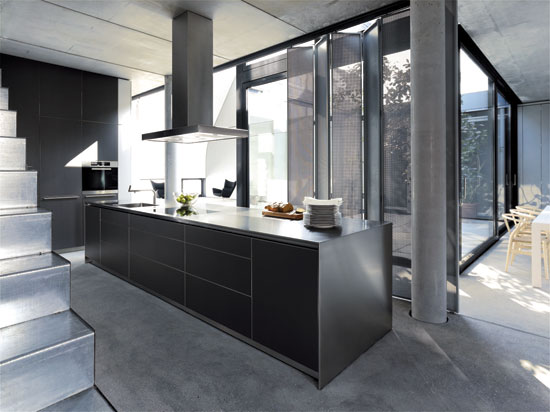 |
The monoblock integrates worktop, burners, and plumbing, and appears like a solid block of metal with no visible seams for a true minimalist design. Photo courtesy of bulthaup |
| An Open Mobile Kitchen | ||
Following the minimalist principles of “clearing away anything superfluous” and allowing maximum customization, this kitchen prototype assures that everything needed for a two-person household is visible at a glance and within reach. Starting from the philosophical origins of every living space—the fire and water points—this open and mobile kitchen is based on a workshop layout comprising three main elements: a workbench housing the sink and cooker; tool cabinet for utensils, crockery, and food; and appliance cabinet for the oven, dishwasher, and fridge. Opening the in-door storage doors provides an overview of the entire kitchen domain. Once the doors are closed again, the beauty of the simple purpose-oriented form becomes clearly apparent. The compaction of the storage space makes pull-outs and drawers unnecessary. Even the diversity of units is smartly minimalist—just a few basic types and materials, such as oak and walnut veneer combined with worktops made from stainless steel, oak, walnut, and gray sandstone offer a limitless range of design variations. With its flexible structure, modules can be combined at will, and new worktops, water points or appliance modules can be put onto the workbench, adapting it to the owner’s personal habits and customs. Elements can be extended to suit if the circle of family and friends increases, for example, or when new appliances come on the market, and changed if a different material is desired for the worktop.
|
The Worktop
Only inches thick, today's minimalist worktops are the most rigorously used areas of the kitchen and must be able to withstand pressure, shocks, acidity, and heat as well as being easy and quick to clean. Although worktops can be less than half an inch thick, they are engineered to withstand extreme pressure. Such ultra-thin worktops are offered in stainless steel, seamless laminate, laminate with aluminum edges, and synthetic stone. Dyeing the laminate throughout the surface and edges gives the best results. Laminate worktops can also be edged in aluminum to protect against pressure and humidity.
Function Boxes
The most important area in the kitchen is the worktop, with preparation and serving zones, a water point, and a cooking area. In the classic fitted kitchen, there are only two solutions, as the worktop is neglected. Some minimalist kitchens, however, provide solutions that maximize use of this previously neglected area—the space between the worktop and the wall unit. The solution is based on “function boxes,” which provide storage for spices, oil and vinegar, kitchen tools, knives, and small containers—most things needed in preparing or serving food, cooking, and cleaning. When the doors of the function boxes are closed, the pure minimalist form of the kitchen is uninterrupted, concealing ergonomically arranged storage solutions. The doors can be opened either completely or just halfway. In contrast to sliding doors, where one side is always hidden away, this solution keeps everything in view.
There are function boxes in variable widths, depths, and heights that can be planned for all manner of uses to suit individual needs. Wing lights with fluorescent tubes can be integrated for illumination and energy efficiency, as can an integrated mixer tap for the water point that is positioned high enough to enable even bulky crockery to be rinsed easily and tall pots to be filled with water.
Function boxes can be subdivided to create multiple compartments. The lower flap of the boxes can house both dividers and a knife block, or cutting and breakfast boards. Some manufacturers also offer compatible containers for storing sugar, salt, utensils, and other foods for an integrated look and operational efficiency. Such containers can be arranged according to themes, type or season, creating colorful patterns that reflect the preferences and cooking style of the user in a unique way. While a good fit for the functional spaces of the kitchen, the containers can be easily removed and placed in other locations, such as on dining tables or worktops, shifting their orientation from chef to diner.
Shutters or top box units placed on top of the worktop or integrated into tall units offer extensive storage space and can accommodate even larger kitchen appliances stored at ergonomically sensible heights. Equipped with compartment shelves, insert boxes, sockets, and interior lighting, shutter boxes can remain open in daily use and give the user access to their contents without doors getting in the way. One visual advantage characterized by the shutter units in particular is that they accentuate the horizontal lines.
Just how well a cupboard door closes or opens, and the width of the angle of access to the interior space are determined primarily by the hinge. Ultra-flat hinges with noise-attenuated stops that extend minimally into the interior and have an opening angle of at least 105 degrees invite easy access to units and insure that internal drawers can be removed without problems. When drawers have the same stops and attenuation as the pull-outs, they have the same interior width, enabling fronts to be planned end-to-end without any interruption to the horizontal line.
Water Points
As an average of 60 percent of time in the kitchen is spent on preparing, serving, and washing up around the water point, it is important to carefully consider the ergonomics, functionality, and versatility of sinks, flat basins, and drain boards. Drain boards and sinks in various widths can be welded into a utility recess, with the number and position customized. Functional elements, such as strainers, bowls, and basins, as well as sliding elements such as the cutting board and the sliding grater can enhance the water point and should be positioned accordingly. Special mixer taps are another convenience. Mounted to the wall or a function box, they can control the flow and temperature of the water with just one hand—an asset to a busy cook with a hot pot or bowl in the other hand.
Extractor Hoods
Extractor hoods that vent to the outside via ducts or in a recirculating version utilizing an environmentally safe, easily cleanable activated carbon filter are important elements in any kitchen. Powerful, quiet motors, versatile functions, logical interfaces, accommodation for controlling additional sources of light, easy cleaning, and care are all desirable attributes of a kitchen extractor, as is the ability to be installed over a kitchen island, on the ceiling, or over the cooking area on the wall. Extractor hoods with a swivel-out filter facilitate removing and cleaning the grease and odor filter. Hoods with integrated motors are designed for a higher level of performance than needed for normal use, meaning they are significantly quieter in normal mode and deliver optimum extraction under extreme conditions. Motor heads equipped with sound insulation and sufficient suction space will result in quieter operation.
An innovation in extractor hoods that combines optimized lighting and air filtration, is a virtually portable appliance that features a horizontal floating line of light in combination with an aerodynamic shape similar to that of wind instruments. When activated, the two slats that run along the lighting strip open to the side and expose the entire extraction surface. The aerodynamic side view lets one actually feel the movement and compaction of the rising air. Hanging from two steel cables, the appliance's position can be easily changed should the configuration of the kitchen need to be altered or should cooks prefer to prepare food such as fondue, raclette, or teppanyaki dishes directly at the table.
Interior Spaces—Organizing Storage
Having enough space for pots and pans, kitchen tools and accessories, appliances, bottles, and food is a key challenge in a kitchen. In minimalist kitchens, the active wall and reduced thickness of the fronts and worktops create greater storage capacity. Base units of different sizes and shapes play a crucial supporting role in the kitchen, and offer ample storage space, especially when equipped with interior drawers, deep storage drawers, doors as well as various internal fittings including bread cutting board, crockery inserts, tray, porcelain boxes, and multi-slicers since these make maximum use of the full unit depth.
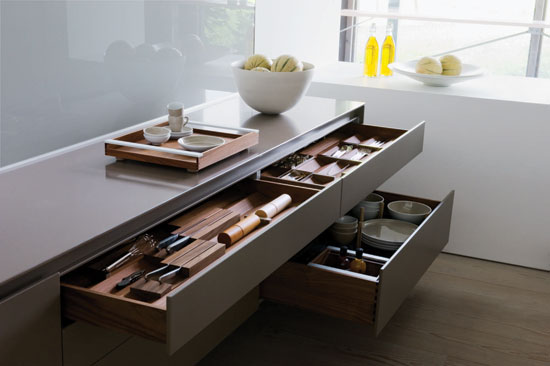 |
Interior fitting system is based on the concept of functional prisms and high-quality accessories. Photo courtesy of bulthaup |
Interior Fitting Systems
Manufacturers have introduced an alternative interior fitting system for drawers and pull-out elements that signifies a break with the rigid organizational structures of the past. The old systems made it necessary to store silverware, cooking utensils, and other tools in right-angled containers, and to align working practices with these organizational structures and not the other way around. As the exclusive focus on function has been replaced by a focus on intuition, these newer systems allow users to design—and redesign—drawers as they see fit, with easy access for both right-and left-handed users.
The interior fitting system is based on the concept of functional prisms—geometric structures that create functional and aesthetic order. Drawers carved into angled troughs feature triangular blocks of steel that slide to define the exact size of the spaces that the user needs to accommodate utensils, boxes, knife blocks, trays, and jars for seasonings and spices, etc.; they are also designed to slot into the prism structure. These flexible sliding elements organize and hold utensils in place, in a custom scheme that can be easily configured and reconfigured, creating a flexible and highly personal storage that grows organically with the evolving needs of the user. With the prism arrangement, which can be integrated into all pull-outs, drawer interiors take on a seamless, attractive look, almost like a collage, regardless of how the dividers and accessories are arranged.
Accessories and Related Furniture
The kitchen and areas around it form the heart of the home and are the hub of domestic communication. Some kitchen system manufacturers have gone beyond the strict confines of the kitchen, offering furniture with the same minimalist design and ergonomic function and similar thin material thicknesses and accentuation of horizontals to create an overall lightweight appearance in adjoining living and dining rooms. Options include tables, chairs, bar stools keyed to kitchen systems height, and benches that are either affixed to the multifunctional wall's carrier frame or freestanding.
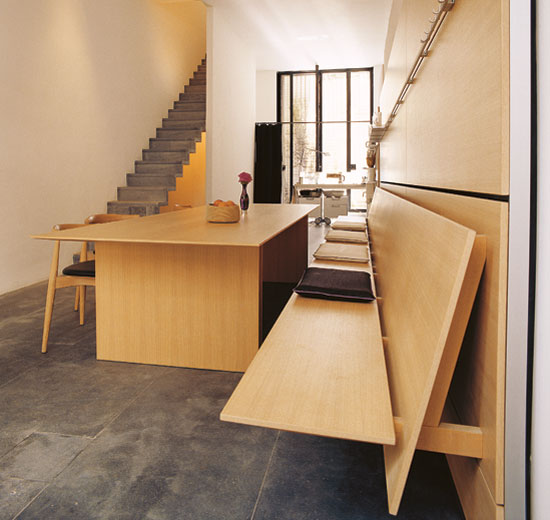 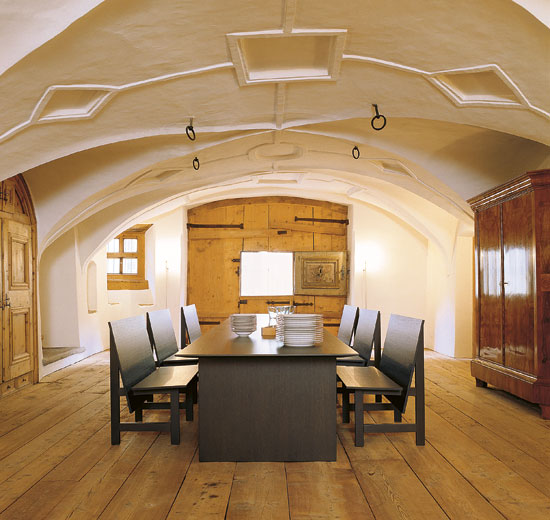 |
The tables and benches shown here in natural gray oak (top) and black-brown oak (bottom) highlight the lightweight appearance and horizontal orientation of the minimalist kitchen. The cross-section of the materials used is no more than 16 mm and it can withstand heavy loads. Photos courtesy of bulthaup |
Design Considerations
In designing a minimalist kitchen, architects will want to consider a range of aesthetic and sustainability issues.
Materials
In high-end minimalist kitchens, quality solid wood, laminates, stainless steel, synthetic stone, veneers, and even concrete are all design possibilities, and can be customized to create complementary or contrasting design schemes. Among the most modern and versatile materials, aluminum is a well-recognized choice for the minimalist kitchen. To prevent oxidation in the daily use of the kitchen, aluminum fronts should be anodized. In fact, strip anodizing of aluminum surfaces is the only means of offering aluminum in a reproducible color quality. Finishes are available in a natural aluminum, bronze, and darker gray which in some cases is achieved through development of an eloxate using organic pigment to imbue the finish with a pleasantly dark appearance that changes with the reflection of the light.
Ultra-thin solid wood fronts are produced in a sandwich construction, combining three solid wooden layers with two stabilizing aluminum sheets. The minimal thickness of the solid wood and the fine aluminum sheets are visible at the edge. Wood can be finished to appear either smooth and sleek or in a coarser version. In some cases, wood fronts such as those in oak can be fashioned to maintain the rough structure of the original saw cut, finished with an invisible natural coat for protection. Rather than sealing the surface, the lacquer accentuates the impression of the saw cuts, enhancing the natural character and vitality of the wood. Rough-sawn woods can be stained in darker shades to blend harmoniously with other kitchen elements.
In terms of veneer, the quality horizontal-veneered fronts require selection from a single tree trunk so that the grain of the wood continues in a horizontal direction over the entire front. Some woods such as maple, cherry, oak can be veneered either horizontally or vertically. For darker veneers, architects should consider treated woods such as smoked oak. Light and dark veneer strips are crafted to achieve a plank character.
Glossy and matte lacquer finishes are available in an extensive range of colors. Glossy, high-quality “piano” lacquers are striking, particularly in white, which contrasts well with materials such as stainless steel, aluminum, and wood. Matte lacquer surfaces are used more for setting sophisticated color accents in the kitchen and adjoining rooms, or for transitions between the kitchen and the neighboring areas.
Green Issues
At the heart of sustainability is conservation of resources and the notion of doing more with less. By focusing on individual preferences and systems that can be easily altered and expanded over time, minimalist kitchens have a long service life, without the need for costly full-scale renovations as needs change. This organic growth is based on the quality of materials, and the universality and flexibility of the systems. While the overarching design of such kitchens is inherently green, architects can delve further into sustainability by opting for appliances such as water-saving dishwashers, energy-efficient refrigerators as well as environmentally sound materials that are sturdy enough to withstand use, easily cleanable, and responsibly sourced. Wood used for veneer, for example, should be obtained from sustainably managed forests and treated with water-based, environmentally friendly lacquer.
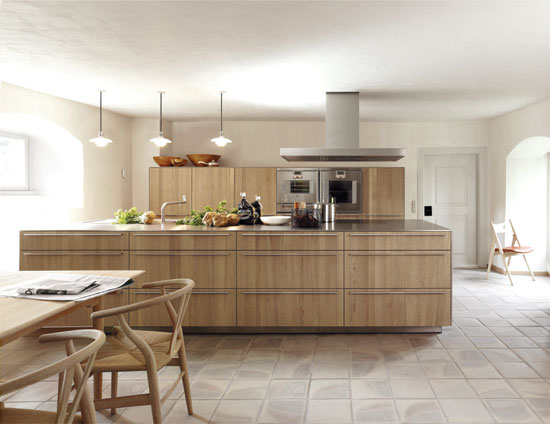 |
Wood from managed forests adds to the kitchen’s sustainability. Photo courtesy of bulthaup |
| Minimalist Kitchen Creates Community for Artists | ||
On an estate in southwest France, four former agricultural buildings were transformed to artists’ studios, with a large communal kitchen that serves as the center of artistic and community life. The original configuration of the kitchen and dining area has been recreated in a contemporary form. A 6-meter-long kitchen island with stainless steel worktop is complemented by a large table with a variety of chairs. No tall units were used. A multifunctional wall holds all the necessary appliances and utensils. The result is a living space with the character of a loft in which people can cook, eat, work, and—last but not least—party. The wood selected for the fronts of the kitchen cabinets is a rarely used and difficult-to-work-with apple veneer. But as the building stands in the midst of an orchard, selection of the apple wood was a desirable way to reference the surrounding land. Extra care was taken with the veneer to give it a characteristic planked finish. The aluminum wall panels, the concrete floor, and the planked apple cabinet fronts create an exciting visual contrast within the room. |
| A House Built On a Hill | ||
In designing a house built on a hillside near Barcelona, architect Arturo Frediani sought to have the building fit harmoniously with its surroundings in a way that none of its neighbors would lose their view of the sea. Satisfying the client’s request for a room that opened out onto the landscape, but maintained privacy in a contemporary way, Frediani chose to make the kitchen the hub of the home. A dining area, a comfortable living area with bookshelves and hearth, and a separate office area all adjoin the kitchen. The large windows draw nature into the room, literally creating a spacious living area. The kitchen looks as though it emanates from the wall, with its laser-edged white laminate fronts complemented by the seamlessly finished worktop. A wall-hung oak bench, and matching table and chairs continue this well-thought-out interior design. |
Meeting Aesthetic, Ergonomic, and Sustainability Goals
Today, the kitchen is the hub of the home, and ideally an aesthetic, comfortable environment in which to cook and entertain. Minimalist kitchens offer the benefits of high-style and ergonomically designed work areas within a space so lightweight it seems to “float.” By making all work and storage spaces within easy reach, by taking advantage of an active wall and maximizing the space between the countertop and the wall unit, and providing drawers and pull-outs with a system to shape, structure, and fill the interior space, minimal kitchens bring a new level of intuitive function to a traditional area. People are able to easily configure and reconfigure systems and accessories according to their changing needs, succeeding in the minimalist tenet of doing more with less. The fact that this attribute is also consistent with sustainability goals is an added advantage, and one that is increasingly necessary in the face of today's pressing concerns of global warming and climate change.
 |
bulthaup's signature kitchens are revered for their clean lines, ergonomic layout, and precision German engineering and manufacturing—all fundamental to creating timeless living spaces that are meant to be used. The company's systems suit any aesthetic or environment and strike a perfect balance between the home's architecture and the way one lives. www.bulthaup.com |

